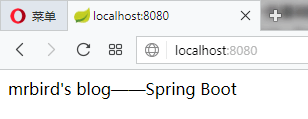定制Banner
Spring Boot项目在启动的时候会有一个默认的启动图案:
1 | . ____ _ __ _ _ |
我们可以把这个图案修改为自己想要的。在src/main/resources目录下新建banner.txt文件,然后将自己的图案黏贴进去即可。ASCII图案可通过网站http://www.network-science.de/ascii/一键生成,比如输入mrbird生成图案后复制到banner.txt,启动项目,eclipse控制台输出如下:
1 | _ _ _ _ _ _ |
banner也可以关闭,在main方法中:
1 | public static void main(String[] args) { |
全局配置文件
在src/main/resources目录下,Spring Boot提供了一个名为application.properties的全局配置文件,可对一些默认配置的配置值进行修改。
自定义属性值
Spring Boot允许我们在application.properties下自定义一些属性,比如:
1 | mrbird.blog.name=mrbird's blog |
定义一个BlogProperties Bean,通过@Value("${属性名}")来加载配置文件中的属性值:
1 |
|
编写IndexController,注入该Bean:
1 |
|
启动项目,访问http://localhost:8080,页面显示如下:

在属性非常多的情况下,也可以定义一个和配置文件对应的Bean:
1 | (prefix="mrbird.blog") |
通过注解@ConfigurationProperties(prefix="mrbird.blog")指明了属性的通用前缀,通用前缀加属性名和配置文件的属性名一一对应。
除此之外还需在Spring Boot入口类加上注解@EnableConfigurationProperties({ConfigBean.class})来启用该配置:
1 |
|
之后便可在IndexController中注入该Bean,并使用了:
1 |
|
属性间的引用
在application.properties配置文件中,各个属性可以相互引用,如下:
1 | mrbird.blog.name=mrbird's blog |
自定义配置文件
除了可以在application.properties里配置属性,我们还可以自定义一个配置文件。在src/main/resources目录下新建一个test.properties:
1 | test.name=KangKang |
定义一个对应该配置文件的Bean:
1 |
|
注解@PropertySource("classpath:test.properties")指明了使用哪个配置文件。要使用该配置Bean,同样也需要在入口类里使用注解@EnableConfigurationProperties({TestConfigBean.class})来启用该配置。
通过命令行设置属性值
在运行Spring Boot jar文件时,可以使用命令java -jar xxx.jar --server.port=8081来改变端口的值。这条命令等价于我们手动到application.properties中修改(如果没有这条属性的话就添加)server.port属性的值为8081。
如果不想项目的配置被命令行修改,可以在入口文件的main方法中进行如下设置:
1 | public static void main(String[] args) { |
使用xml配置
虽然Spring Boot并不推荐我们继续使用xml配置,但如果出现不得不使用xml配置的情况,Spring Boot允许我们在入口类里通过注解@ImportResource({"classpath:some-application.xml"})来引入xml配置文件。
Profile配置
Profile用来针对不同的环境下使用不同的配置文件,多环境配置文件必须以application-{profile}.properties的格式命,其中{profile}为环境标识。比如定义两个配置文件:
application-dev.properties:开发环境
1
server.port=8080
application-prod.properties:生产环境
1
server.port=8081
至于哪个具体的配置文件会被加载,需要在application.properties文件中通过spring.profiles.active属性来设置,其值对应{profile}值。
如:spring.profiles.active=dev就会加载application-dev.properties配置文件内容。可以在运行jar文件的时候使用命令java -jar xxx.jar --spring.profiles.active={profile}切换不同的环境配置。

